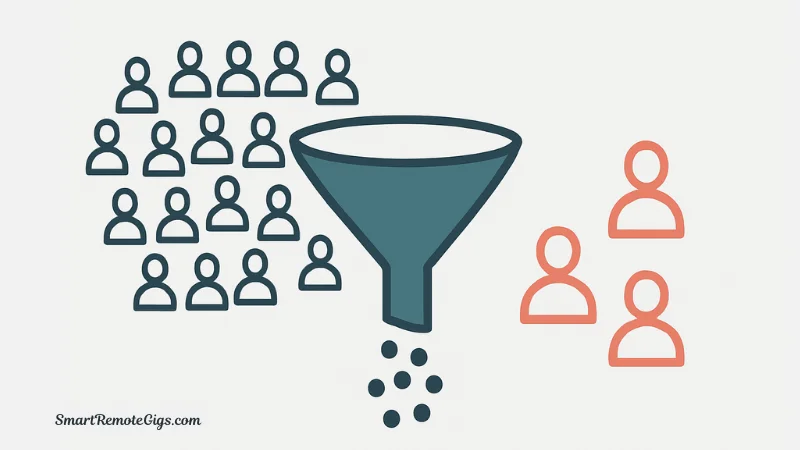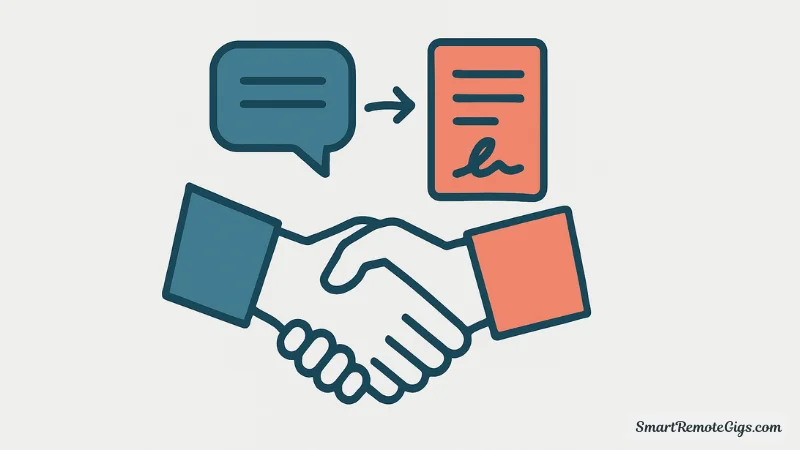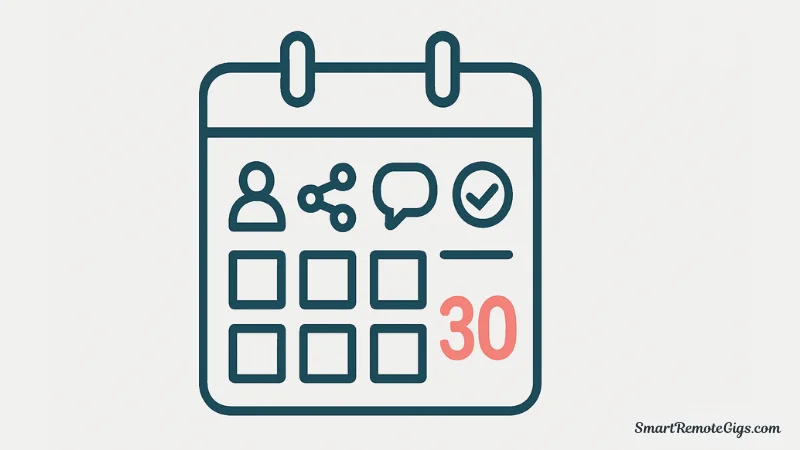Most freelancers think LinkedIn is just for finding jobs or posting inspirational quotes. The reality? LinkedIn is one of the most powerful platforms to get clients on LinkedIn—but only if you approach it strategically and authentically.
The problem is that most freelancers sabotage themselves with spammy connection requests, desperate sales pitches in DMs, and self-promotional posts that scream “I need work.” This approach doesn’t just fail—it damages your professional reputation.
This guide provides a complete 4-step framework for using LinkedIn as a client acquisition machine without being pushy, spammy, or inauthentic. You’ll learn how to position yourself as a valuable professional, build genuine relationships with potential clients, and convert those relationships into paid work—all while maintaining your integrity and professionalism.
The 4-Step Framework:
- Transform your profile into a client magnet
- Find and connect with ideal clients strategically
- Engage authentically to build trust and visibility
- Convert conversations into client relationships
Step 1: Turn Your Profile into a Client Magnet

Your LinkedIn profile isn’t a resume—it’s a sales page. Every element should be optimized to attract your ideal clients and make them want to work with you.
According to LinkedIn’s own research, profiles with complete information receive 21 times more profile views and 9 times more connection requests. But completion isn’t enough; your profile must speak directly to potential clients’ needs.
Your Headline: Beyond “Freelance [Job Title]”
Your headline is the most visible part of your profile, appearing in search results, connection requests, and every comment you make. The default “Freelance Writer” or “Graphic Designer” wastes this valuable real estate.
Instead, craft a value-driven headline that answers:
- Who you help
- What outcome you deliver
- What makes your approach unique
Generic headline: “Freelance Content Writer”
Client-magnet headline: “Helping B2B SaaS Companies Drive Organic Traffic Through SEO-Focused Content | 200+ Published Articles”
The formula: [Action Verb] + [Target Client Type] + [Specific Outcome] + [Credibility Indicator]
More examples:
- “Building High-Converting Shopify Stores for Handmade Product Brands | 50+ Stores Launched”
- “Email Marketing for Online Course Creators | Specializing in Launch Sequences That Convert”
- “UX Designer for FinTech Startups | Creating Intuitive Interfaces That Reduce User Drop-Off”
Your “About” Section: Focus on Client Pain Points
Most freelancers write their About section like a biography. Clients don’t care about your journey—they care about whether you can solve their problems.
Your ‘About’ Section Blueprint:
- Paragraph 1 (The Problem): Start by describing the core problem your ideal client faces.
- “Most e-commerce brands struggle to turn email subscribers into repeat customers. Their welcome sequences are generic, their promotional emails feel pushy, and their abandoned cart campaigns miss opportunities to build relationships.”
- Paragraph 2 (Your Solution): Explain your unique approach to solving that problem.
- “I specialize in creating email sequences that feel personal, provide genuine value, and build long-term customer relationships—not just drive one-time sales.”
- Paragraph 3 (The Proof): Provide credibility with results, experience, or social proof.
- “Over the past three years, I’ve helped 40+ e-commerce brands increase their email revenue by an average of 34%. My sequences combine strategic psychology, compelling storytelling, and data-driven optimization.”
- Paragraph 4 (The CTA): End with a clear call to action, inviting a conversation.
- “If you’re looking to transform your email marketing from an afterthought into your most profitable channel, let’s talk. Send me a message or check out my featured work below.”
Pro tip: Write in second person (“you”) and focus on outcomes, not processes. Replace “I write email sequences” with “I help you turn subscribers into loyal customers.”
The Featured Section: Your Mini-Portfolio
The Featured section sits prominently on your profile and allows you to showcase specific work samples, case studies, or testimonials. This is where potential clients go from interested to convinced.
What to feature:
- Case studies with measurable results
- Your best work samples with context
- Client testimonials formatted as images or PDFs
- Articles or content that demonstrate your expertise
- Video introductions or project walkthroughs
Format matters: Don’t just link to external websites. Create visually appealing documents or images with compelling headlines that showcase results: “How I Increased Email Revenue by 47% in 60 Days” beats “Client Project #3.”
Make sure your freelance portfolio is fully developed and linked in this section to provide comprehensive proof of your capabilities.
Get Recommendations: Social Proof That Sells
LinkedIn recommendations are third-party endorsements visible on your profile. They’re far more credible than self-promotion.
How to get quality recommendations:
- Identify 3-5 satisfied clients from recent projects
- Make it easy for them: Send a brief email: “I’m updating my LinkedIn profile and would be grateful for a recommendation highlighting [specific aspect of your work]. If helpful, I’m happy to draft something you can edit.”
- Offer reciprocity: “I’d also be glad to write a recommendation for you.”
What makes a powerful recommendation:
- Specific results or outcomes you delivered
- The client’s initial problem or challenge
- Your unique approach or what made you different
- Personal qualities (reliability, communication, creativity)
Step 2: Find and Connect with Your Ideal Clients

Random networking is inefficient. Strategic connection building focuses on people who could become clients or refer clients to you.
Using LinkedIn Search to Build a Prospect List
LinkedIn’s search functionality is powerful when used strategically. Here’s how to identify potential clients:
Basic Search Strategy:
- Use the search bar to find decision-makers in your target industry
- Apply filters:
- Title: Marketing Director, Founder, CEO, VP of Operations (whoever controls hiring)
- Industry: E-commerce, Software, Consulting, Healthcare, etc.
- Location: Your target geographic market
- Company size: Matches your ideal client (startups, mid-size, enterprise)
- Look for engagement signals:
- Active posters (more likely to see and respond to your content)
- Recent job changes (often need new vendors/freelancers)
- Growing companies (increasing demand for services)
Pro Tip: Advanced Search with Sales Navigator
LinkedIn Sales Navigator is LinkedIn’s premium search tool. While not required, it dramatically improves your targeting with filters like:
- Years of experience
- Seniority level
- Company growth rate
- Technology used
Build Your Prospect List
Create a simple spreadsheet with 50-100 potential clients, tracking their name, company, title, and one personalized detail (recent post, shared connection, company news).
The Perfect Connection Request (Template Included)
Generic connection requests get ignored. Personalized requests that demonstrate genuine interest get accepted at much higher rates.
The anatomy of an effective connection request:
- Brief mention of why you’re connecting
- Specific reference to them or their work
- No immediate sales pitch
Template:
Hi [Name],
I came across your recent post about [specific topic] and found your perspective on [specific point] particularly insightful.
I work with [type of company] on [your specialty] and would love to connect and follow your insights on [their industry/topic].
Best,
[Your name]Real example:
Hi Jennifer,
I noticed you recently joined Acme SaaS as Head of Marketing—congratulations! I've been following Acme's growth and was impressed by your recent content strategy pivot.
I specialize in SEO content for SaaS companies and would love to connect and follow your marketing insights.
Best,
AlexWhat NOT to say:
- “I’d love to tell you about my services”
- “Let’s discuss how I can help your business”
- “Checking to see if you need [your service]”
- Generic templates with no personalization
Connection request strategy:
- Send 5-10 personalized requests daily
- Focus on quality over quantity
- Accept that 30-50% acceptance rate is normal and healthy
- Never send the same message twice
Step 3: The Engage & Nurture Strategy

This is where most freelancers fail—and where the biggest opportunities exist. Consistently engaging with your network builds trust, visibility, and top-of-mind awareness without direct selling.
The 90/10 Rule of Engagement
For every 10 LinkedIn activities, 9 should provide value to others and only 1 should be about you.
Value-providing activities (90%):
- Thoughtful comments on others’ posts
- Sharing useful articles or resources
- Liking and engaging with connections’ content
- Answering questions in your area of expertise
- Congratulating professional milestones
Self-promotional activities (10%):
- Posts about your services
- Case study shares
- Client testimonials
- Availability announcements
Why this works: People do business with those they know, like, and trust. Consistent value-building creates all three without feeling pushy.
How to Write Comments That Get Noticed
Most LinkedIn comments are worthless: “Great post!” or “Thanks for sharing!” These add no value and make you invisible.
Strategic commenting approach:
1. Add Genuine Insight
“This aligns with what I’ve seen working with SaaS companies—the key is often segmenting based on user behavior rather than just demographics.”
2. Share a Relevant Experience
“We tested this exact approach with a client last quarter and saw a 28% increase in conversions. The critical factor was [specific detail].”
3. Ask a Thoughtful Question
“Have you found this strategy works differently for B2B versus B2C audiences? I’ve noticed [specific observation].”
4. Respectfully Challenge or Expand
“Interesting perspective. I wonder if this might vary by industry—in healthcare, we’ve found that [alternative approach] tends to work better because [specific reason].”
The goal: Demonstrate expertise and add value to the conversation, making the original poster and other readers see you as knowledgeable and helpful.
Daily engagement routine:
- Spend 15-20 minutes on LinkedIn
- Comment thoughtfully on 5-8 posts from potential clients or industry influencers
- Like/engage with 10-15 additional posts
- Respond to any comments on your own content
Creating Your Own Content
While engagement is crucial, creating your own content amplifies your visibility and positions you as a thought leader.
What to post about:
- Specific lessons learned from client work (without revealing confidential information)
- Industry trends and your unique perspective
- Common mistakes in your field and how to avoid them
- Behind-the-scenes of your process or approach
- Results and case studies (with client permission)
Content that performs well:
- Personal stories with professional lessons
- Contrarian but well-reasoned takes
- Data-driven insights with clear takeaways
- Practical how-to advice
- “Here’s what I learned from [experience]” posts
Posting frequency: 2-3 times per week is ideal. Consistency matters more than volume.
Content formula:
Hook: Start with an attention-grabbing statement or question
Context: Briefly explain the situation or background
Insight: Share your main point or lesson
Example: Provide specific details or evidence
Takeaway: End with clear, actionable advice or a questionStep 4: From Conversation to Client

The previous steps build visibility and trust. This step converts relationships into paying work.
When and How to Move to the DMs
Timing is critical. Move to direct messages too early and you seem pushy. Wait too long and opportunities pass.
Green light signals to send a DM:
- They’ve engaged with your content multiple times
- They’ve asked a question or sought advice publicly
- They’ve mentioned a challenge you can solve
- You’ve had a back-and-forth in comments
- They’ve visited your profile after your interactions
Red light signals (don’t DM yet):
- You just connected
- They’ve never engaged with your content
- You have no interaction history
- Your only connection is industry-related
The transition message template:
Hi [Name],
I've enjoyed our conversations about [topic] over the past few weeks. I noticed you mentioned [specific challenge they've discussed] and thought I might have some insights that could help.
Would you be open to a brief 15-minute call? I've worked with several [type of company] on exactly this issue and would be happy to share what's worked.
No pressure at all—just thought it might be valuable.
Best,
[Your name]What makes this work:
- References existing relationship
- Focuses on helping, not selling
- Low-commitment ask (15 minutes)
- Gives them an easy out
The LinkedIn Pitch: Turning Conversations into Proposals
Once you’ve established rapport and moved to direct conversation, it’s time to transition to a business discussion.
The soft pitch approach:
After your initial call or exchange, send a follow-up message that outlines how you can help:
Hi [Name],
Thanks for taking the time to chat yesterday. Based on our conversation about [specific challenge], I have a few specific ideas for how we might tackle [desired outcome].
Would it make sense for me to put together a brief proposal outlining [specific deliverable] and how we could work together?
Let me know if you'd find that helpful.
Best,
[Your name]If they agree, create a simple proposal that includes:
- Clear understanding of their problem
- Your proposed solution and approach
- Specific deliverables and timeline
- Pricing (project-based or retainer)
- Next steps
For crafting the perfect pitch when you’re ready to formalize the proposal, use our proven template: The Perfect Freelance Cold Pitch Template (Gets Replies).
Handling Common Objections
Objection: “We don’t have budget right now”
Your Response: “I completely understand. Would it be helpful if I checked back in [timeframe, e.g., Q2] when budgets might open up? In the meantime, I’m happy to share relevant resources.”
Objection: “We’re already working with someone”
Your Response: “That’s great—always good to have reliable partners. If anything changes or you need additional support, I’d be happy to chat. Feel free to reach out anytime.”
Objection: “I need to think about it”
Your Response: “Of course! Is there any specific information I can provide that would help with your decision? I’m also happy to start with a smaller pilot project if that makes the decision easier.”
Your 30-Day LinkedIn Action Plan

Here’s a concrete plan to get freelance clients on LinkedIn over the next month:
Week 1: Optimize
- Rewrite your headline using the value-driven formula
- Revamp your About section focusing on client problems
- Add 3-5 pieces to your Featured section
- Request 2-3 recommendations from past clients
Week 2: Connect
- Build a prospect list of 50 ideal clients
- Send 5-10 personalized connection requests daily
- Comment thoughtfully on 5-8 posts per day
- Post your first piece of original content
Week 3: Engage
- Continue daily commenting and engagement
- Post 2 additional pieces of content
- Respond to all comments on your posts
- Start conversations with engaged connections
Week 4: Convert
- Identify 3-5 connections showing buying signals
- Send transition-to-DM messages to qualified prospects
- Schedule calls with interested parties
- Send proposals to those who express interest
Maintain ongoing: 15-20 minutes of daily engagement, 2-3 posts per week, 5-10 new connections weekly.
Conclusion: Build Relationships, Not Just Connections
The key to success on LinkedIn isn’t complex tactics or growth hacks—it’s authentic relationship building at scale. By optimizing your profile to attract ideal clients, strategically connecting with decision-makers, consistently providing value through engagement, and thoughtfully converting conversations to business relationships, you create a sustainable client acquisition system.
The freelancers who succeed on LinkedIn don’t spam connection requests or pitch in DMs. They position themselves as valuable professionals, contribute genuinely to their community, and let their expertise speak through their interactions.
The 4-step framework recap:
- Optimize: Transform your profile into a client magnet that clearly communicates your value
- Connect: Build a strategic network of ideal clients using personalized outreach
- Engage: Provide consistent value through thoughtful comments and helpful content
- Convert: Turn relationships into clients through strategic, helpful conversations
LinkedIn isn’t a quick fix for immediate income needs—it’s a long-term asset that compounds over time. The connections you make this month might become clients in three months, six months, or even next year. But with consistent effort following this framework, you’ll build a pipeline of warm prospects who already know, like, and trust you before the first sales conversation.
For a complete strategy on finding freelance clients across all channels, including how LinkedIn fits into your overall client acquisition plan, check out our comprehensive guide: How to Find Freelance Clients: A 7-Step Roadmap for Beginners (2025).
Start with Step 1 today. Optimize your headline and About section before you do anything else. Everything else builds on that foundation.
Your next client is already on LinkedIn. They just don’t know you exist yet.
Learn a 4-step framework to get freelance clients on LinkedIn by optimizing your profile, connecting strategically, engaging authentically, and converting conversations into paid work without being spammy.
Total Time: 30 days
Turn Your Profile into a Client Magnet

1. Craft a value-driven headline that explains who you help and the outcome you deliver (e.g., “Helping B2B SaaS Companies Drive Traffic with SEO Content”).
2. Rewrite your ‘About’ section to focus on client problems, your unique solution, proof of your results, and a clear call to action.
3. Add your best work samples, case studies, or testimonials to the ‘Featured’ section to act as a mini-portfolio.
4. Request 2-3 specific recommendations from past clients to build social proof and credibility.
Find and Connect with Your Ideal Clients

1. Use LinkedIn’s search filters (Title, Industry, Company Size) to identify 50-100 potential clients who fit your ideal customer profile.
2. Create a simple spreadsheet to track your prospects and your outreach activities.
3. Send 5-10 personalized connection requests daily. Your message should reference a specific post, shared interest, or company achievement, never a sales pitch.
Engage Authentically to Build Trust and Visibility

1. Follow the 90/10 rule: 90% of your activity should provide value to others (commenting, sharing), while only 10% is self-promotional.
2. Spend 15-20 minutes daily leaving insightful, value-adding comments on posts from potential clients and industry leaders.
3. Post your own helpful content 2-3 times per week, sharing lessons learned, industry insights, or case studies to position yourself as an expert.
Convert Conversations into Client Relationships

1. Identify buying signals (e.g., they’ve engaged with your content multiple times, mentioned a challenge you can solve) before moving a conversation to DMs.
2. Use a transition message that references your existing relationship and focuses on offering help, not on selling.
3. After an initial call, follow up with a simple proposal that outlines your understanding of their problem, your solution, deliverables, and pricing.
Tools:
- A computer with internet access
- A LinkedIn Account
- A simple spreadsheet application (e.g., Google Sheets, Microsoft Excel)
- Optional: LinkedIn Sales Navigator subscription






